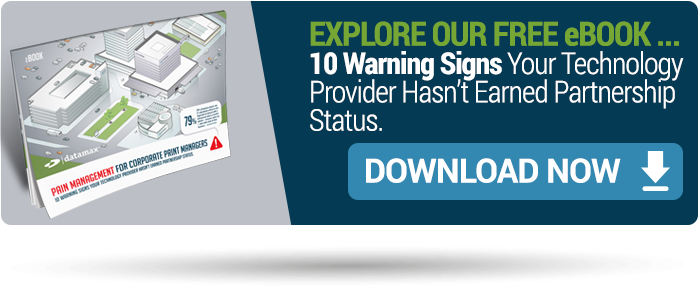
“Since the burden of requesting service is mine, my vendor isn’t managing much — let alone my account.” — Jene T., IT Director
The late folk country singer Guy Clark, a Monahans, TX native, once noted: “You look out over the West Texans plains, and you can see 50 miles. Stand on a tuna can, you can see for 100.”
For organizations managing a large fleet of copiers and printers, you need 100-mile visibility of your provider's service and support methodologies. Rather than being confronted with a series of storms on the road in front of you (increased downtime, communication issues, inaccurate billing) you should expect clear visibility up front from your technology partner.
Otherwise, you're broke down on the side of the road, uncertain if and when help will arrive.
5 service areas in which Corporate Accounts should expect full visibility and visual results:
1. How Service is Communicated.
Communication is the fundamental element of any positive service relationship.
In voicing your service needs, you need flexibility. How many ways can your service/Support Requests be communicated? Is there an online customer portal to quickly submit urgent service needs, with live support communication at a single location? Can you connect via phone directly to the necessary party? Or are you on an endless string of transfers?
Communication should be proactive and effortless on your part. A CEB Global study found that for every ten customers who have a high-effort service experience, nine will become disloyal and eight will say something negative about the brand to others. Your service team should ANTICIPATE - both in their conversations with you and in their technical capabilities - what your next service issue might be. For instance, what kind of “Proactive Service Alerts” are automated within the device management software of your copier, to begin the resolution process on your behalf?
Find out how clear communication will be moving forward.
2. How Service is Delivered.
Proactive service delivery today is expected. Proactive maintenance on your copier is enabled by the available data on your machine for technicians to quickly resolve issues before you’re down. It helps significantly increase uptime, preventing common device issues before they escalate in nature and necessitate service dispatch. Automated service alerts for common issues like errors and jams help your service team quickly provide resolution...often before your workflow is directly affected.
Additionally, preventative maintenance calls should not only be a component of your service agreement, but should be designed to meet your individual business preference and convenience.
Resolution relies heavily on actual device insight. How much data can your technician collect on your equipment when an issue arises, and how quickly? Utilizing software embedded on your machine, a technician receives automated service alerts for errors, jams, and other similar issues, and he or she can also pull up extensive equipment service data on a given machine from their mobile devices.
Another element? Technician expertise. Manufacturer distinctions such as Canon’s ATSP certification require literally hundreds of hours of hands-on and online training. The job function-based exams are designed to measure both the knowledge and the demonstration of the skills that are required in real-world settings for a support professional against a set of standards for competency and performance.
Seek clarity on this. Ask your potential service partner what expertise they offer.
3. How Service is Measured.
Your partner should be able to show you the numbers.
Service performance categories should be measured on a regular basis, and you should have full visibility into the numbers for everything from "Response Time" to "Accuracy of Billing."
Major accounts should benefit from an enhanced response time, in which your partner will maintain a guaranteed average of on-site response time for service.
Beyond a general response time, what can you have guaranteed in Response + Resolution? This measurement is essentially where the rubber meets the road, clearly defining when your business can expect to be up and running again.
Response + Resolution time should be calculated based on the time the service call is placed to the time the device is fully operational. It should also include printers and print production systems.
Seek clarity on the average uptime you can expect, calculated by business days and the working hours within each day. Furthermore, find out the maximum amount time your device will remain in a down state, including MFPs, printers and production systems.
Can your service partner show you the numbers? Will they?
4. How Service is Escalated.
The approach should be to equip, not to escalate. But when you do issues arise, what level of depth does your office equipment partner have with reinforcements?
For example, the Canon Advanced Partner Program, offers support such as priority Canon service training and support, and access to senior-level management.
Your partner should quickly initiate and own escalation processes through Original Equipment Manufacturer (OEM) or Original Software Developer (OSD) support tickets to ensure problem-solving responsiveness to persistent solutions support issues. They should also work hand-in-hand with the OEM or OSD through the entire life of the support ticket, and be the initial response/point of contact for all Solutions Support requests.
If all else fails, can your service partner stand in the gap with necessary reinforcements?
5. How Service is Reviewed.
As stated earlier, communication is key. And regular interaction from an account management should be an ongoing process initiated by your technology partner.
A Partnership Business Review should reassess the current state of your fleet and any changes, as well as visualize best practices moving forward. Under a regularly scheduled Partnership Review and Planning Meeting effectively covers the following elements of our current agreements, in addition to any other client-based needs that arise:
Partnership Review:
- All hardware and solution support.
- Overall performance statistics.
- Invoicing and overall cost analysis.
- Fleet utilization and output volume distribution.
Partnership Planning:
- Any facility/location changes?
- Any business application changes?
- Any upcoming projects requiring additional technology support?
- Any assistance in better tracking print output from your devices?
- Any areas or processes where your partner could better support you?
- Any areas where communications or response could be enhanced?
Looking into the operations of your current fleet, and visualizing the road ahead, how high is your visibility into service and support? Are you seeing visual results? Interested in learning more to see if the Datamax Key Account Program (DKAP) is a good fit for your organization? Let's visit!
Cleayton Mills is the Vice President of Sales at Datamax Texas and the Head of the Datamax Key Account Program (DKAP). He can be reached at (800) 633-1526.


